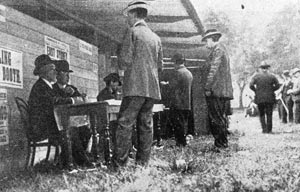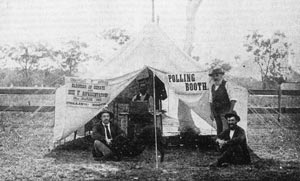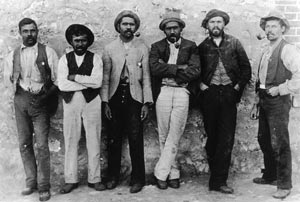Who could vote?

Polling booth in Hyde Park, Sydney
Town and Country Journal, 6 April 1901
State Library of New South Wales
Anyone eligible to vote for the lower house in each state parliament was eligible to vote in the first federal elections for both the Senate and the House of Representatives. All the states required that a voter be at least 21 years of age, and a British subject. There were residential qualifications varying between 6 and 12 months for voters in each of the states, but these were waived for property owners in Victoria and Queensland. In Tasmania, there was a small property qualification.

Polling booth at Jennings near Tenterfield, NSW
Town and Country Journal, 11 May 1901
State Library of New South Wales
Each elector could vote only once for each house. Voting was not compulsory, as it is today, and was conducted by secret ballot.
Aboriginal Vote

Aboriginal men at Point McLeay, SA, in 1900
State Library of South Australia
While Aboriginal people had the right to vote in South Australian state, and therefore federal, elections in 1901, it is doubtful that many exercised that right. However, records show that a number of Aboriginal people did vote at the Point McLeay mission in South Australia.
At the time of Federation, Queensland and Western Australian laws specifically prevented Aboriginal people from enrolling to vote unless they owned freehold property. In the other states, Aborigines had the same voting rights as other citizens. It is likely that many were unable to vote because they did not meet property or residential requirements, or because they were in receipt of charity.
With the passage of the Commonwealth Franchise Act in 1902, Aborigines lost the right to enrol as voters for federal elections, and did not regain it in full until 1962.
Women's Vote
As women had attained the right to vote in South Australia in 1894 and Western Australia in 1899, women could vote in the first federal elections for those states. They also had the right to stand as candidates in South Australia, although no woman did stand.
|


